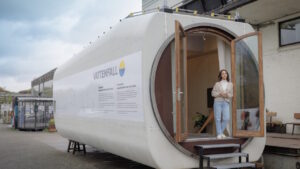Ergon Energy has announced the winner of its first tender to provide ground-breaking grid-based battery storage, in what could be the first of hundreds of such installations across its vast network in Queensland that will reduce its need to build more poles and wires.
 Ergon Energy says 20 systems that comprise 50 Lithium-Ion type batteries and a nominal capacity of 25kVA and 100kWh each will start to be deployed in the middle of next year, after a tender was won by US-based energy and storage company S&C Electric Company.
Ergon Energy says 20 systems that comprise 50 Lithium-Ion type batteries and a nominal capacity of 25kVA and 100kWh each will start to be deployed in the middle of next year, after a tender was won by US-based energy and storage company S&C Electric Company.
The Grid Utility Support Systems (GUSS) will be used to avoid upgrades of single wire high voltage lines (known as SWER) which are common to Ergon’s sprawling network and can cost $2 million to upgrade.
CEO Ian McLeod says GUSS systems could help cut the cost of augmentation by 35 per cent. Because of this they require no subsidy and “hundreds” could be deployed over time.
The design of the units has been developed over nearly 10 years. They are designed to be charged overnight when consumption is at its lowest and discharge during the day. This can reduce peak demand, and help integrate solar PV output.
“This is a first for Ergon and Australia,” McLeod said in a statement.
“This technology has been proven and made ready for real-world deployment without subsidies to Ergon which is also unique for this kind of technology.
“Using a battery-based system in place of traditional network augmentation will not only deliver better value for Ergon and customers, it will help drive similar technology and integration on the electricity network.”
The units will be able to store enough energy to power the average home for up to five days. Ergon says it will help the network interact with customer solar PV installations more effectively, and help avoid costly issues sometimes created by exported power from rooftop solar.
Ergon has one of the highest penetration rates of solar, with 339MW of solar on nary 100,000 households and businesses in Ergon’s network. However, the problem with the “thin wire” network meant it was forced to ban some installations, or prevent others from exporting back into the grid. Battery storage could overcome those issues.
“There is a commonly accepted theory that in the future we could be combining home storage of power connected to, and backed up by, the existing electricity network,” McLeod said.
“When we talk about power “stored” at home, this could be through solar-charged batteries in your house, thermal storage such as hot water storage units or even your electric car connected at home.
“The process of sharing stored energy around existing networks presents challenges however, but GUSS is delivering many answers to this puzzle.
“Combining and sharing stored power across multiple customer premises around sections of electricity network is a solution to peak demand issues – a conundrum under examination in the electricity industry.
“If stored energy could be fed back into the network to help relieve peak demand on our network, this could mean less investment needed on infrastructure and hence less cost needed to be passed on to customers.”










